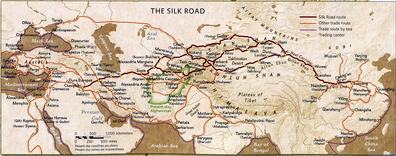Support from Wabash Center will support curricula on re-drawing the map of world religion.
January 21, 2016

Maps have a rich and influential history that informs the study and practice of religion. The stories they tell, however, can be misleading, or at least limited, says Associate Professor of Religion Lillian Larsen.
Supported by a generous grant from the Wabash Center for Teaching and Learning in Theology and Religion, and in collaboration with Shana Higgins (interdisciplinary & area studies librarian), Douglas Flewelling (associate professor - MS GIS)/Steve Benzek (adjunct faculty - MS GIS/Cohort 12) and faculty and staff in the Center for Spatial Studies, Larsen has embarked on a project to develop curricula that will help students research, reconstruct and, to some degree, re-draw the map of world religion (http://library.redlands.edu/redrawmap).
If that sounds like an ambitious endeavor, it is. But Larsen has seen how introducing critical geographic, information and spatial literacy into the study of religion can lead students to new insight and understanding. She sees great value in inviting students to re-think maps in ways that more closely align with the complex role religion plays in society, because how one understands religion is to some degree a function of how it has been represented geographically.
Exploring how maps have been shaped by religious understanding helps students see that “in defining religion, maps can be both powerful and at the same time misrepresentative.” For example, simply noting which traditions are included, emphasized and/or ‘left off’ a given map, can help students think about religion as a cultural, economic and political force in both positive and negative ways. “This moves the conversation beyond polarities that too often present religion in simplistic either/or categories.” It instead invites exploration of hybrid landscapes, shaped by lived experience and real world settings.
Studying religion through lenses informed by geographical and spatial awareness also gives students “permission to engage religion” while developing a more critically nuanced view of its historical and contemporary expression. “Students can find themselves on the map and put themselves back in the story.”
While Larsen has been conducting small mapping projects with her religious studies classes for a number of years, this grant—chosen from among 60 competing projects by the Wabash Center—allows Larsen and her colleagues to develop a model for using digital tools to foster critical literacies that can enrich not only courses in religious studies, but also the broader humanities and spatial studies curriculum.
Three initial workshops this spring—which students can take as the lab component of a religious studies, humanities or spatial studies class—will delve into the key issues of mapping, researching and re-presenting religion.
The first workshop, presented with the MS GIS program, will use GIS and mapping tools to ‘re-draw’ customary maps of world religions in light of historical trade, travel and cultural networks. The second workshop, developed in close collaboration with the Armacost Library, will explore how we think about and research religion in all its social, economic, geographic, environmental and literary dimensions. Adding local relevance to the project, the third workshop, organized in collaboration with the Center for Spatial Studies, will be aimed at re-conceptualizing the religious landscapes linked (and separated) by the contemporary “Silk Roads” (a.k.a. freeways) that define communities of the Inland Empire.
Ultimately, through well established partnerships, Larsen and her University of Redlands associates hope to develop a model that links the humanities and the sciences, and infuses digital initiatives with interdisciplinary critical literacies.
Created and sustained by grants from Lilly Endowment Inc., the Wabash Center for Teaching and Learning in Theology and Religion seeks to enhance and strengthen education in North American theological schools, colleges and universities.

